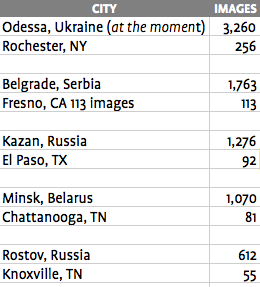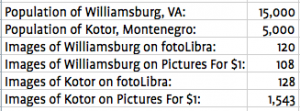Posts Tagged ‘images’
The Russians Are Coming!
March 12th, 2014by Gwyn Headley
Managing Director
Tags: $1, 25 million, Belgrade, Chattanooga, dollar, El Paso, fotoLibra, Fresno, images, Kazan, Knoxville, Kotor, Minsk, Montenegro, Odessa, picture library, pictures for a dollar, Rochester, Rostov, Russians, stock agency, Williamsburg
25 million images for a dollar each!
Yet another ‘stock agency’ has bulk-emailed the world (why should spam trouble them?) to tell us we can buy images from them for a dollar each.
Of course you can’t actually buy a picture from them for a dollar, despite what they promise. You have to start by paying a minimum of ten dollars, at which point they’ll throw in nine extra pictures (which you may or may not want) for free.
The pound, the euro, the yen and the rouble don’t concern them; they only want your dollars.
The business model is to blind buyers with price and quantity, and gloss over content and quality. Pile ’em high, sell ’em cheap. It’s a well-used model.
But talking of content and quality, the balance of image subjects seems wrong for a website which appears to be US-based and aimed primarily at American buyers. Compare these eastern and western cities, all with populations around the million mark. Here are the number of images Pictures For A Dollar (not its real name, natch) has of each location:
As for my headline, I have no idea if this site has anything to do with our Russian friends. But there does seem to be a definite Eastern flavour to the content. As the table above demonstrates, there are ten times as many images of former Soviet bloc cities than of American cities. Which is very useful if you are publishing to the Eastern European market.
Check out these two tourist destinations:
Where did this Pictures For A Dollar site acquire its images, do you think? From all the figures quoted, it certainly looks more Eastern than Western.
I assume they own all these images, so they don’t have to pay the photographers. Therefore all the business costs are pumped into marketing the static stock. There is no indication that there will be new additions to the 25 million images they hold — the website baldly states “Pictures For A Dollar is not accepting contributors at this time.”
Why does this upset me? Because this has nothing to do with photography. Photographers are not welcome on this site.
This is a commodity sale, which will directly affect the livelihood of yet more photographers. I very much doubt that the photographers who supplied the majority of images which ended up on Pictures For A Dollar are going to see a cent for their work. And I don’t think that’s fair.
What worries me is how can a picture library (British usage) or stock agency (American usage) like fotoLibra compete?
I hope it will be by providing well-keyworded, precise, high-quality, up-to-date AND historical images that people actually want and need, not a dubious flytip of cheaply acquired bulk collections that might pass at a pinch.
Or do you have other ideas?
Selling Your Images
January 2nd, 2013by Gwyn Headley
Managing Director
Tags: Accountability, bonuses, bureaucratic, contracts, copyright, educational, EU, European, fotoLibra, global corporations, grants, grim, images, incentives, inflexible, Jude The Invisible, Jude The Obscure, monolithic, new possibilities, ordeals, organisations, outlets, overseas, photographers, picture libraries, procedures, procurement, public money, public sector, revenue, suppliers, taxes, Transparency, Welsh
A Happy New Year to you!
We’re always looking for new outlets to which to sell fotoLibra members’ images, and between Christmas and the New Year we had a very interesting meeting with an extremely high-powered yet friendly executive who lives close by fotoLibra’s Hertfordshire office.
There is a vast European educational and public sector out there which is largely untapped by normal picture libraries because like most organisations funded with public money, Accountability & Transparency in Procurement are their watchwords. This inevitably means routes to market are not so much Jude The Obscure as Jude The Invisible — there is no way a company such as ours can ring up a representative from one of these monolithic organisations and mutter “pssst! wanna buy some images?” We couldn’t even find out who to talk to.
Everything has to take place through bureaucratic procurement procedures, grim, inflexible ordeals which are less concerned about the quality, range and variety of the images we have to offer than discovering the number of ethnic Welsh people we employ and our policy towards recycling hard disks.
By the simple expedient of not paying taxes, global corporations can afford to employ the sort of people who love ticking all these boxes, so they get flooded with grants, incentives and bonuses as well as three-yearly contracts to be exclusive coffee and image suppliers to the Ruritarian Public Affairs Ministry.
We struggle on. Thanks to our executive friend, we now have at least an inkling of the riches lying out there, just beyond our reach at the moment. But we have more contacts who understand this world far better than our simple viewpoint, and we believe they may be prepared to help us.
Like every other picture library, our sales have fallen over the past three or four years, and we are doing everything in our power to restore lost revenue and explore new possibilities. If our photographers aren’t making money, we’re not making money, so we need to find out about these overseas procurement procedures fast. Even so, our friend warned us “Don’t expect anything to happen for three years. This is the world of bureaucracy, after all.”
We went on to the website of one of these organisations and found this rather good and clearly explained guide to copyright for picture users in the EU. I should point out that this was discovered on the English-language subset of a foreign-language quango’s website:
Information for image users
When will you have dealings with us? Virtually every publication, every website and every television programme uses images. Copyright law stipulates that the author’s permission is required for this. That permission is usually linked to a financial payment: image creators must, after all, live on the income from their creative labours. Apart from a couple of exceptions, publishers and producers are obliged to trace the creators of the images in order to ask permission for publication. The fact that this is not always easy does not detract from this obligation. Our agency enables the user to arrange this effectively in advance. Over 50,000 image creators both in this country and abroad are registered with us and we issue licences on their behalf. Our rates are harmonised with sister organisations abroad. Our agency arranges permission for publication.
Asking permission is compulsory Users are often confused as to what they can and cannot do under copyright law. The golden rule is: anyone who wants to publish someone else’s image must ask permission for this from the creator or their heirs. This obligation only lapses 70 years after the death of the artist. Hence the work of Rembrandt is rights-free, but that of Picasso is not. Anyone who publishes a picture of a painting by Picasso in a book or leaflet without permission runs the risk of having to pay damages.
That’s nice and clear and straightforward.
Not every government announcement has to be draped in the cobwebs of obscurity. And this was English as a foreign language. I wish I could write as clearly. I think we could work with these people.
The New Picture Call Tab
April 2nd, 2009by Gwyn Headley
Managing Director
We’ve just added a new tab to the fotoLibra members’ Control Centre which helps photographers organise and assess their responses to Jacqui Norman’s Picture Calls. This is what it does:
• supplies the complete original Picture Call brief
• shows a sample line of images submitted to the Picture Call
• shows which images the member has submitted to the Picture Call
• allows members to add images directly to the Picture Call from their Portfolios
• allows members to remove images or swap them from one Picture Call to another
• shows all the images offered for each Picture Call so members can see what’s needed and what’s not
We think it’s a major improvement on the old system, and offers far more transparency which we were unable to provide until we created this interface. And from what we’ve heard so far, all our members agree with us. After the screen shots come a few sample comments. I know I’ve been accused (by Jacqui) of running a Dear Leader-style ‘democracy’, but I can honestly say the reactions have been 100% favourable.
Hold on to your seats, because there’s more to come!


Jacqui and all at fotoLibra — impressed. Superbly done! A great visual concept — I love it. —Keith Erskine
The new Picture Call tab — I think it is superb. —Philippa Wood
Yep, love the Picture Call tab. Very clever to split out all my entries above all the rest and incorporating the brief makes it entirely user friendly. Well done. —Phil Dickson
I liked the additions to the site — well done. —Peter Vallance
The new Picture Call tab looks and feels excellent. —Nick Jenkins
The new Picture Call tab is great. This was a great addition to the fotoLibra web site. Thanks for a great site that helps us market our work. —Jim Walker



